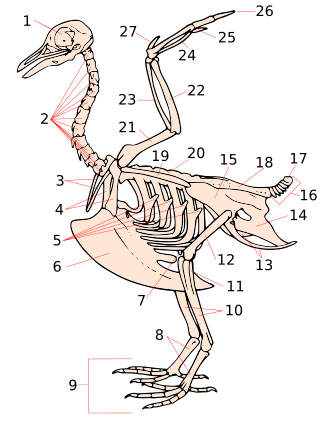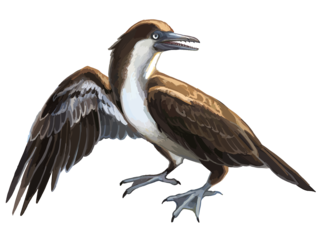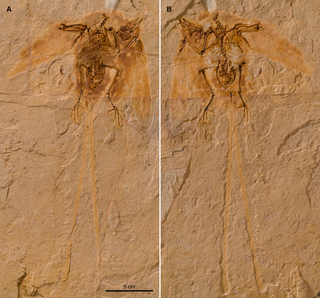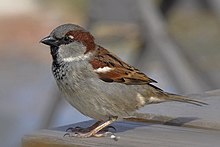
Confuciusornis is a genus of basal crow-sized avialan from the Early Cretaceous Period of the Yixian and Jiufotang Formations of China, dating from 125 to 120 million years ago. Like modern birds, Confuciusornis had a toothless beak, but closer and later relatives of modern birds such as Hesperornis and Ichthyornis were toothed, indicating that the loss of teeth occurred convergently in Confuciusornis and living birds. It was thought to be the oldest known bird to have a beak, though this title now belongs to an earlier relative Eoconfuciusornis. It was named after the Chinese moral philosopher Confucius. Confuciusornis is one of the most abundant vertebrates found in the Yixian Formation, and several hundred complete specimens have been found.

The Enantiornithes, also known as enantiornithines or enantiornitheans in literature, are a group of extinct avialans, the most abundant and diverse group known from the Mesozoic era. Almost all retained teeth and clawed fingers on each wing, but otherwise looked much like modern birds externally. Over eighty species of Enantiornithes have been named, but some names represent only single bones, so it is likely that not all are valid. The Enantiornithes became extinct at the Cretaceous–Paleogene boundary, along with Hesperornithes and all other non-avian dinosaurs.

Pygostyle describes a skeletal condition in which the final few caudal vertebrae are fused into a single ossification, supporting the tail feathers and musculature. In modern birds, the rectrices attach to these. The pygostyle is the main component of the uropygium, a structure colloquially known as the bishop's nose, parson's nose, pope's nose, or sultan's nose. This is the fleshy protuberance visible at the posterior end of a bird that has been dressed for cooking. It has a swollen appearance because it also contains the uropygial gland that produces preen oil.

Yanornis is an extinct genus of fish-eating Early Cretaceous birds. Two species have been described, both from Liaoning province, China: Yanornis martini, based on several fossils found in the 120-million-year-old Jiufotang Formation at Chaoyang, and Yanornis guozhangi, from the 124-million-year-old Yixian Formation.
The Xiagou Formation is the middle strata of the Xinminbao Group. It is named for its type site in Xiagou, in the Changma Basin of Gansu Province, northwestern China and is considered Early Cretaceous in age. It is known outside the specialized world of Chinese geology as the site of a Lagerstätte in which the fossils were preserved of Gansus yumenensis, the earliest true modern bird.

Avialae is a clade containing the only living dinosaurs, the birds, and their closest relatives. It is usually defined as all theropod dinosaurs more closely related to birds (Aves) than to deinonychosaurs, though alternative definitions are occasionally used.

Confuciusornithidae is an extinct family of pygostylian avialans known from the Early Cretaceous, found in northern China. They are commonly placed as a sister group to Ornithothoraces, a group that contains all extant birds along with their closest extinct relatives. Confuciusornithidae contains four genera, possessing both shafted and non-shafted (downy) feathers. They are also noted for their distinctive pair of ribbon-like tail feathers of disputed function.

Yixianornis is a bird genus from the early Cretaceous period. Its remains have been found in the Jiufotang Formation at Chaoyang dated to the early Aptian age, around 120 million years ago. Only one species, Yixianornis grabaui, is known at present. The specific name, grabaui, is named after American paleontologist Amadeus William Grabau, who surveyed China in the early 20th century.

Ornithothoraces is a group of avialan dinosaurs that includes all enantiornithes and the euornithes, which includes modern birds and their closest ancestors. The name Ornithothoraces means "bird thoraxes". This refers to the modern, highly advanced anatomy of the thorax that gave the ornithothoracines superior flight capability compared with more primitive avialans. This anatomy includes a large, keeled breastbone, elongated coracoids and a modified glenoid joint in the shoulder, and a semi-rigid rib cage. In spite of this at least the sternum seems to have developed convergently rather than being a true homology.

Avisauridae is a family of extinct enantiornithine dinosaurs from the Cretaceous period, distinguished by several features of their ankle bones. Depending on the definition used, Avisauridae is either a broad and widespread group of advanced enantiornithines, or a small family within that group, restricted to species from the Late Cretaceous of North and South America.

Shanweiniao is a genus of long-snouted enantiornithean birds from Early Cretaceous China. One species is known, Shanweiniao cooperorum. There is one known fossil, a slab and counterslab. The fossil is in the collection of the Dalian Natural History Museum, and has accession number DNHM D1878/1 and DNHM1878/2. It was collected from the Lower Cretaceous Dawangzhengzi Beds, middle Yixian Formation, from Lingyuan in the Liaoning Province, China.

Songlingornithidae is a family of basal euornithean dinosaurs from the Early Cretaceous of China. All known specimens come from the Jiufotang Formation and the Yixian Formation, dating to the early Barremian and Aptian ages, 125–120 million years ago.

Longipterygidae is a family of early enantiornithean avialans from the Early Cretaceous epoch of China. All known specimens come from the Jiufotang Formation and Yixian Formation, dating to the early Aptian age, 125-120 million years ago.

Euornithes is a natural group which includes the most recent common ancestor of all avialans closer to modern birds than to Sinornis.

Sulcavis is a genus of enantiornithean birds. One species is named, Sulcavis geeorum. The fossil was found in Early Cretaceous rocks in Liaoning Province, China.

Bohaiornithidae is a group of early predatory enantiornithean dinosaurs from the early Cretaceous Period of China. All known specimens come from the Jiufotang Formation and Yixian Formation, dating to the early Aptian age, 125–120 million years ago. Bohaiornithidae was first coined by Wang and colleagues in 2014. They defined it as the natural group formed by all descendants of the common ancestor of the type species, Bohaiornis guoi, and Shenqiornis mengi.

Luis María Chiappe is an Argentine paleontologist born in Buenos Aires who is best known for his discovery of the first sauropod nesting sites in the badlands of Patagonia in 1997 and for his work on the origin and early evolution of Mesozoic birds. He is currently the Vice President of Research and Collections at the Natural History Museum of Los Angeles County and director of the museum's Dinosaur Institute. He was a postdoctoral researcher at the American Museum of Natural History, New York after immigrating from Argentina. Chiappe is currently the curator of the award winning Dinosaur Hall at the Natural History Museum of Los Angeles County, an adjunct professor at the University of Southern California, BBC advisor and author of scientific and popular books.

Pengornithidae is a group of early enantiornithines from the early Cretaceous Period of China, with the putative member Falcatakely possibly extending this clade's range into the Late Cretaceous of Madagascar, and several putative pengornithids also hail from this formation. Specimens of these animals have been found both in the Huajiying Formation and Jiufotang Formation of Liaoning and Hebei provinces, dating from the Hauterivian age to the Aptian age.

Jingmai Kathleen O'Connor is a paleontologist who works as a curator at the Field Museum.



























